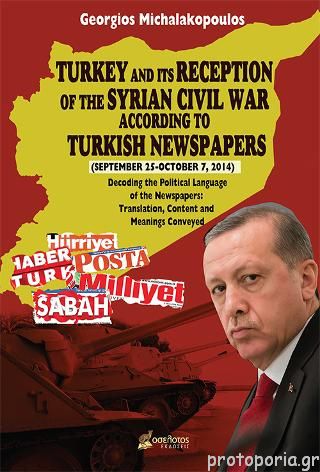0
Your Καλαθι
Turkey and its Reception of the Syrian Civil War according to Turkish Newspapers (September 25-Octob
Decoding the Political Language of the Newspapers: Translation, Content and Meanings Conveyed
Έκπτωση
10%

10%

Περιγραφή
“Space and memory are maps on which these changes leave their traces”
“the ‘news’ link up with and support
the ‘continuity of survival’ instinct of the Turkish Republic…”
The above two sentences constitute the main arguments upon which the present research is based upon. More specifically, this book explores the use of newspapers by the Turkish state apparatus, and its “guardians”, as a means to propagate its (their) dominant ideology. Something that is accomplished via intangible tools such as the concealed meanings found behind newspaper headlines, front pages and news presentation.
In this way, the present study represents, above all, a “mental exercise” on finding, firstly, the best-suited academic concepts and methods within the discourse analysis area -broadly speaking- in order to validate how information (and ideology alike) is produced through newspaper headlines and their first pages and secondly, on deciphering the hidden meanings therein.
Monika Bednarek discussed on “emotional talk” and Teun van Dijk stressed that “facts are better represented and memorized if they involve and arouse strong emotions”. On the other part, Vijay Bhatia has written about the specific use of context related to a particular discourse community and Theo van Leeuwen offered interesting views on visual communication.
These are the concepts applied and used here, in conjunction to other very important ones, so as to establish that within Turkey emotions are constantly stimulated by the Press, and the media in general, and the citizens must abide unconsciously to the tenet that the “State survival” is everyone’s duty.
One characteristic feature of this policy involves the extensive use of red (the allusion to the ‘ay y?ld?z’, the Turkish flag), yellow (a visually ‘aggressive’ color used for warning) and black (used to denote serious events) colors while blue serves as a color for presenting “softer” news with a human-centered dimension.
As it is aptly argued a new model of polarization is present within Turkish society. Therefore, the need for stirring up national feelings and demonstrating the need to protect one’s country from the “Other” compels these two policies to cooperate perfectly well corresponding to a ‘unifying element’ arrangement.
It seems that the foreign policy followed by AKP towards its periphery has created a state-centered, religiously-shaped, neo-nationalistic approach, whose shocking consequences begin to be unveiled just now.
“the ‘news’ link up with and support
the ‘continuity of survival’ instinct of the Turkish Republic…”
The above two sentences constitute the main arguments upon which the present research is based upon. More specifically, this book explores the use of newspapers by the Turkish state apparatus, and its “guardians”, as a means to propagate its (their) dominant ideology. Something that is accomplished via intangible tools such as the concealed meanings found behind newspaper headlines, front pages and news presentation.
In this way, the present study represents, above all, a “mental exercise” on finding, firstly, the best-suited academic concepts and methods within the discourse analysis area -broadly speaking- in order to validate how information (and ideology alike) is produced through newspaper headlines and their first pages and secondly, on deciphering the hidden meanings therein.
Monika Bednarek discussed on “emotional talk” and Teun van Dijk stressed that “facts are better represented and memorized if they involve and arouse strong emotions”. On the other part, Vijay Bhatia has written about the specific use of context related to a particular discourse community and Theo van Leeuwen offered interesting views on visual communication.
These are the concepts applied and used here, in conjunction to other very important ones, so as to establish that within Turkey emotions are constantly stimulated by the Press, and the media in general, and the citizens must abide unconsciously to the tenet that the “State survival” is everyone’s duty.
One characteristic feature of this policy involves the extensive use of red (the allusion to the ‘ay y?ld?z’, the Turkish flag), yellow (a visually ‘aggressive’ color used for warning) and black (used to denote serious events) colors while blue serves as a color for presenting “softer” news with a human-centered dimension.
As it is aptly argued a new model of polarization is present within Turkish society. Therefore, the need for stirring up national feelings and demonstrating the need to protect one’s country from the “Other” compels these two policies to cooperate perfectly well corresponding to a ‘unifying element’ arrangement.
It seems that the foreign policy followed by AKP towards its periphery has created a state-centered, religiously-shaped, neo-nationalistic approach, whose shocking consequences begin to be unveiled just now.
Κριτικές
Δεν βρέθηκαν δημοσιεύσεις





